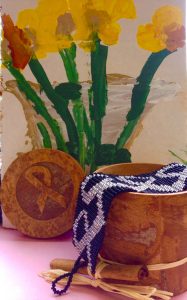 It was like any other day in autumn. The brightly covered leaves that had once been attached to the cascading tree branches had finally let go. The summer heat had taken its toll and there they were lying on the ground fading into the Earth’s surface. I remember looking out of the bedroom window witnessing the bare limbs in disbelief. Finally, I called out to my husband to tell him of a discovery I’d just made. Like the leaves, I found myself falling to the floor, with tears in my eyes wondering. I was 30…twelve years younger than my mother when she discovered she had breast cancer.
It was like any other day in autumn. The brightly covered leaves that had once been attached to the cascading tree branches had finally let go. The summer heat had taken its toll and there they were lying on the ground fading into the Earth’s surface. I remember looking out of the bedroom window witnessing the bare limbs in disbelief. Finally, I called out to my husband to tell him of a discovery I’d just made. Like the leaves, I found myself falling to the floor, with tears in my eyes wondering. I was 30…twelve years younger than my mother when she discovered she had breast cancer.
We often go through life unaware. Sooner or later, things that lie beneath the surface begin to emerge. They take the shape of lumps, coughs, pains, nausea or some other manifestation. What we don’t know, but soon discover, could end up being a life lesson – opening our eyes to a whole new world.
In 1998, I found myself practicing what I preached. I was a researcher and educator on health and wellness who had an interest in breast and ovarian cancers due to my family history. I had taken special courses to learn more and worked with women of all ages who had been diagnosed or had a family member who was. I’d heard their frustrations and was now experiencing my own. Twenty years ago, it was not uncommon to get the “wait and see” advice or the casual concern from a medical provider due to age. My mom, in the late 1980s, took control and asked for a biopsy. We’re certainly glad she did or we may not have had a happy ending with her story.
We are the captain of our own ship. Whether you’ve been diagnosed or coasted around the iceberg, life is full of experiences. As I get older, I realize we’re all connected in some way. Maybe it’s through lab results, friends or similar situations. I believe the key to truly living is not dismissing the negative times. Instead, we should learn and grow from them and share our wisdom or truth with others.
One thing that’s true is that the breath tells us exactly what’s taking place in the body whether we want to admit it or not. The two are so profoundly linked and the breath is important for a multitude of reasons. Everything begins with the breath. We enter this world with those around us anticipating our first breath and we leave the world taking our last. In between, the breath happens. It’s an automatic, involuntary response that we often take for granted. When life really happens, our breath tells us. Think about the varied sayings that correlate the breath with emotions. The times of happiness that took our breath away or the events of fear when we hold our breath. Breathing is the bridge between the mind and body and a diagnosis of cancer undeniably steals the breath away.
In Sanskrit (the ancient language of India), the word breath means prana. Prana is the vital life force or energy that flows through us. Breathing happens to be the only function that we can perform consciously and unconsciously. Yes, it is involuntary but it can be so much more.
The medulla is part of the autonomic nervous system and is critical as it helps transfer neural messages from the brain to the spinal cord and helps regulate heartbeat, blood pressure and breathing to name a few. Breathing, compared with other functions such as digestion or the endocrine system, can be regulated willingly. Good examples of breath control include playing a wind instrument or singing which require focus whereas involuntary requires no attention to maintain.
medulla is part of the autonomic nervous system and is critical as it helps transfer neural messages from the brain to the spinal cord and helps regulate heartbeat, blood pressure and breathing to name a few. Breathing, compared with other functions such as digestion or the endocrine system, can be regulated willingly. Good examples of breath control include playing a wind instrument or singing which require focus whereas involuntary requires no attention to maintain.
Each day we take an average of ~20,000 breaths. Most of them we’re completely unaware of. Because of this, the breath is the first thing I start with when working with individuals who are facing a life crisis or a great deal of stress. It sounds simple, but has a large impact.
The autonomic nervous system consists of two divisions – the sympathetic and the parasympathetic. We’ve all had that “fight or flight” feeling that makes our heart beat faster with short, choppy chest breathing. This type of stress response is part of the sympathetic nervous system. Often, in a crisis, this acute reaction turns into a chronic situation. We may deprive ourselves of much needed oxygen. Over time, the stress hormones surging through the body take its toll often resulting in blood vessel constriction, slowed digestion, nausea, stomachaches, headaches and a suppressed immune system.
How can we combat stress and cultivate a calm and cooperative union of mind, body and ultimately spirit? Mindful breathing! Breathing with awareness has been shown to reduce anxiety, fear and stress that go along with a diagnosis including medical consultations, surgery and treatment. Conscious breathing influences the parasympathetic nervous system which has been called the “rest and digest” system. It relaxes the body and mind and elicits the relaxation response. Studies indicate that deep, diaphragmatic belly breathing can also boost the immune system and assist in decreasing depression.
Now that we’ve looked at the central nervous system and breathing, we’ll take a journey into the respiratory system. Breathing is much more than simply the exchange of fresh oxygen in and the release of carbon dioxide. The diaphragm’s movement that controls our breathing assists the lymphatic system in removing waste from the body.
The lymphatic system has been described as a highway (lymph vessels) with rest stops (lymph nodes). Lymph vessels run through the body and waste is removed along these channels. The breath is critical to the lymphatic system because it doesn’t have a heart to pump things through like the circulatory system has. The breath (and movement of the body) move the waste and, if working properly, can move up to four liters of fluid a day. Without deep breathing or movement, our lymphatic system may not be removing toxins as efficiently as it could. This can impact our overall health and wellness and is especially important if cancer and/or medications during treatment are present in the body.
Let’s discover the breath.
• Find a seat in a quiet location – free from distractions. It can be seated on a yoga mat in a cross legged position. Maybe you’re seated on a bolster or blanket on the floor with legs crossed. Perhaps you’re seated in a chair with your feet flat on the floor.
• Find your breath. Place one hand on your chest and the other on your belly. Simply breathe the way you normally would and notice your hands. Which hand rises more? This reveals if you’re a chest breather or belly breather. Now examine your inhale and exhale. Do you inhale through your nose or mouth? How about your exhale?
Note: It's recommended that we breathe like a baby…take the air into your belly. Also, breathing through the nose elicits the relaxation response.
Learn to breathe.
• Formal – schedule a breathing or meditation practice in a quiet place (begin with 2-3 times a day. Practice for 1 to 2 minutes as you learn and then work your way up. It’s helpful to practice after you brush your teeth to ensure that it gets done and create a new habit. It’s also fun to do with a minty freshness.
• Informal – standing in line, taking a shower, sitting in a meeting, sitting at a stoplight, anytime
Formal breathing lesson
• Sit however feels best for you. Rest your hands on your legs with your arms and shoulders relaxed. Think of an imaginary string on top of your head and your spine tall.
Let’s begin by focusing on our exhalation which is a little out of the ordinary but important. We need to empty the lungs before you inhale.
• Close your eyes. On your exhalation, breathe out slowly through your nose counting to five. During this time, contract your belly which draws your diaphragm in to help deflate your lungs completely. Think of pulling the belly button in towards your spine.
• Before inhaling, pause for ~3 seconds and then slowly inhale counting to five. As you inhale, relax and expand your belly allowing the breath to move in completely. Let your belly inflate like a balloon. Pause for ~3 seconds. Continue with 5-8 breaths.
If your mind starts chattering and not staying in the present moment (most likely it will), without judgement simply return to the breath. Let any to-do lists or concerns wait until you’ve completed this breathing exercise!
Informal breathing lesson
• Wherever you are, notice your breathing. Take the breaths in through the nose and out through the nose. Observe where the breath moves in the body. Allow the breath to move into the belly. Notice your breathing as you move through your morning, day and night.
The breath is always with us. When we breathe with intention, it can be therapeutic, nurture grace and foster resilience. In addition to the benefits mentioned above, conscious breathing can provide stronger lungs and a healthier heart. It can also assist us in being more body aware. In fact, mindful breathing coupled with yoga has been shown to have significant benefits to many, especially those with a cancer diagnosis. The union of breath and yoga are helpful through all stages of a diagnosis, including recovery from surgery and/or reconstruction should that be part of the process. Stay tuned for Part 2 to learn about the lymphatic system and yoga which will be released on October 19th.
 Support Breast Cancer Awareness Month
Support Breast Cancer Awareness Month
Support Breast Cancer Awareness Month. #saslife Click To Tweet
 Practice Breathing
Practice Breathing